Climate Change Impacts on Rainfed Maize Yields in Kansas: Statistical vs. Process-Based Models
Abstract
:1. Introduction
2. Materials and Methods
2.1. Study Region
2.2. Models and Models’ Parameters
2.2.1. Multiple Linear Regression (MLR) Model
2.2.2. Process-Based Model, DSSAT
2.3. Data and Data Sources
2.3.1. Climate Data
2.3.2. Soil Data
2.3.3. Rainfed Maize Yield Data
2.4. Model Evaluation
2.5. Synthetic Climate Change Scenarios
3. Results and Discussion
3.1. Multiple Linear Regression (MLR) Model
3.2. Comparison of Regression and Process-Based Models
3.3. Climate Change Impacts on Predicted Yields
4. Conclusions
Supplementary Materials
Author Contributions
Funding
Data Availability Statement
Acknowledgments
Conflicts of Interest
References
- NOAA. Climate Change: Global Temperature|NOAA Climate.gov. 2023. Available online: http://www.climate.gov/news-features/understanding-climate/climate-change-global-temperature (accessed on 24 January 2023).
- NOAA. Climate at a Glance|National Centers for Environmental Information (NCEI). 2022. Available online: https://www.ncei.noaa.gov/access/monitoring/climate-at-a-glance/ (accessed on 23 January 2023).
- Menne, M.J.; Williams, C.N.; Gleason, B.E.; Rennie, J.J.; Lawrimore, J.H. The Global Historical Climatology Network Monthly Temperature Dataset, Version 4. J. Clim. 2018, 31, 9835–9854. [Google Scholar] [CrossRef]
- Frankson, R.; Kundel, K.E.; Stevens, L.E.; Easterling, D.R.; Lin, X.; Shulski, M.; Umphlett, N.A.; Stiles, C.J. State Climate Summaries for the United States 2022. NOAA Technical Report NESDIS 150. NOAA NESDIS. 2022. Available online: https://statesummaries.ncics.org/chapter/ks (accessed on 19 January 2023).
- Lin, X.; Harrington, J.; Ciampitti, I.; Gowda, P.; Brown, D.; Kisekka, I. Kansas Trends and Changes in Temperature, Precipitation, Drought, and Frost-Free Days from the 1890s to 2015. J. Contemp. Water Res. Educ. 2017, 162, 18–30. [Google Scholar] [CrossRef]
- Maitah, M.; Malec, K.; Maitah, K. Influence of precipitation and temperature on maize production in the Czech Republic from 2002 to 2019. Sci. Rep. 2021, 11, 10467. [Google Scholar] [CrossRef] [PubMed]
- FAO. FAOSTAT. 2021. Available online: https://www.fao.org/faostat/en/#home (accessed on 24 January 2023).
- Erenstein, O.; Jaleta, M.; Sonder, K.; Mottaleb, K.; Prasanna, B. Global maize production, consumption and trade: Trends and R&D implications. Food Secur. 2022, 14, 1295–1319. [Google Scholar] [CrossRef]
- Erenstein, O. The Evolving Maize Sector in Asia: Challenges and Opportunities. J. New Seeds 2010, 11, 1–15. [Google Scholar] [CrossRef]
- Rawat, M. Comparison of Climate Change Impact on Rainfed Maize Yield in Kansas Using Statistical and Process-Based Models. Ph.D. Thesis, Department of Biological & Agricultural Engineering, Kansas State University, Manhattan, KS, USA, 2023. Available online: https://krex.k-state.edu/handle/2097/43336 (accessed on 24 January 2023).
- USDA-NASS. USDA—National Agricultural Statistics Service—Research and Science—CropScape and Cropland Data Layers. 2022. Available online: https://www.nass.usda.gov/Research_and_Science/Cropland/sarsfaqs2.php#Section1_14.0 (accessed on 2 March 2023).
- Arora, N.K. Impact of climate change on agriculture production and its sustainable solutions. Environ. Sustain. 2019, 2, 95–96. [Google Scholar] [CrossRef]
- Malhi, G.S.; Kaur, M.; Kaushik, P. Impact of Climate Change on Agriculture and Its Mitigation Strategies: A Review. Sustainability 2021, 13, 1318. [Google Scholar] [CrossRef]
- Shahzad, A.; Ullah, S.; Dar, A.A.; Sardar, M.F.; Mehmood, T.; Tufail, M.A.; Shakoor, A.; Haris, M. Nexus on climate change: Agriculture and possible solution to cope future climate change stresses. Environ. Sci. Pollut. Res. 2021, 28, 14211–14232. [Google Scholar] [CrossRef]
- Paraschivu, M.; Cotuna, O.; Paraschivu, M.; Olaru, A.L. Effects of Interation between Abiotic Stress and Pathogens in Cereals in the Context of Climate Change: An Overview. Ann. Univ. Craiova Agric. Mont. Cadastre Ser. 2019, 49, 413–424. [Google Scholar]
- Challinor, A.J.; Watson, J.; Lobell, D.B.; Howden, S.M.; Smith, D.R.; Chhetri, N. A meta-analysis of crop yield under climate change and adaptation. Nat. Clim. Chang. 2014, 4, 287–291. [Google Scholar] [CrossRef]
- Su, Y.; Gabrielle, B.; Makowski, D. The impact of climate change on the productivity of conservation agriculture. Nat. Clim. Chang. 2021, 11, 628–633. [Google Scholar] [CrossRef]
- Cooper, M.; Tang, T.; Gho, C.; Hart, T.; Hammer, G.; Messina, C. Integrating genetic gain and gap analysis to predict improvements in crop productivity. Crop. Sci. 2020, 60, 582–604. [Google Scholar] [CrossRef]
- Dai, Z.; Li, Y. A multistage irrigation water allocation model for agricultural land-use planning under uncertainty. Agric. Water Manag. 2013, 129, 69–79. [Google Scholar] [CrossRef]
- Filippi, C.; Mansini, R.; Stevanato, E. Mixed integer linear programming models for optimal crop selection. Comput. Oper. Res. 2017, 81, 26–39. [Google Scholar] [CrossRef]
- Hipólito, J.; Boscolo, D.; Viana, B.F. Landscape and crop management strategies to conserve pollination services and increase yields in tropical coffee farms. Agric. Ecosyst. Environ. 2018, 256, 218–225. [Google Scholar] [CrossRef]
- Abendroth, L.J.; Miguez, F.E.; Castellano, M.J.; Carter, P.R.; Messina, C.D.; Dixon, P.M.; Hatfield, J.L. Lengthening of maize maturity time is not a widespread climate change adaptation strategy in the US Midwest. Glob. Chang. Biol. 2021, 27, 2426–2440. [Google Scholar] [CrossRef] [PubMed]
- Sharma, R.K.; Kumar, S.; Vatta, K.; Bheemanahalli, R.; Dhillon, J.; Reddy, K.N. Impact of recent climate change on corn, rice, and wheat in southeastern USA. Sci. Rep. 2022, 12, 16928. [Google Scholar] [CrossRef]
- Lobell, D.B.; Field, C.B.; Lobell, D.B.; Field, C.B.; Lobell, D.B.; Field, C.B.; Lobell, D.B.; Field, C.B. Global scale climate–crop yield relationships and the impacts of recent warming. Environ. Res. Lett. 2007, 2, 014002. [Google Scholar] [CrossRef]
- Igwe, K.; Sharda, V.; Hefley, T. Evaluating the Impact of Future Seasonal Climate Extremes on Crop Evapotranspiration of Maize in Western Kansas Using a Machine Learning Approach. Land 2023, 12, 1500. [Google Scholar] [CrossRef]
- IPCC (Ed.) Emissions Scenarios: Summary for Policymakers: A Special Report of IPCC Working Group III; IPCC Special Report; Intergovernmental Panel on Climate Change: Geneva, Switzerland, 2000. [Google Scholar]
- Schlenker, W.; Roberts, M.J. Nonlinear temperature effects indicate severe damages to U.S. crop yields under climate change. Proc. Natl. Acad. Sci. USA 2009, 106, 15594–15598. [Google Scholar] [CrossRef] [PubMed]
- Ansarifar, J.; Wang, L.; Archontoulis, S.V. An interaction regression model for crop yield prediction. Sci. Rep. 2021, 11, 17754. [Google Scholar] [CrossRef]
- Roberts, M.J.; Braun, N.O.; Sinclair, T.R.; Lobell, D.B.; Schlenker, W. Comparing and combining process-based crop models and statistical models with some implications for climate change. Environ. Res. Lett. 2017, 12, 095010. [Google Scholar] [CrossRef]
- Southworth, J.; Randolph, J.; Habeck, M.; Doering, O.; Pfeifer, R.; Rao, D.; Johnston, J. Consequences of future climate change and changing climate variability on maize yields in the midwestern United States. Agric. Ecosyst. Environ. 2000, 82, 139–158. [Google Scholar] [CrossRef]
- Edmonds, J.A.; Rosenberg, N.J. Climate Change Impacts for the Conterminous USA: An Integrated Assessment Summary. Clim. Chang. 2005, 69, 151–162. [Google Scholar] [CrossRef]
- Fischer, G.; Shah, M.; Tubiello, F.N.; Van Velhuizen, H. Socio-economic and climate change impacts on agriculture: An integrated assessment, 1990–2080. Philos. Trans. R. Soc. B Biol. Sci. 2005, 360, 2067–2083. [Google Scholar] [CrossRef] [PubMed]
- Parry, M.; Rosenzweig, C.; Livermore, M. Climate change, global food supply and risk of hunger. Philos. Trans. R. Soc. B Biol. Sci. 2005, 360, 2125–2138. [Google Scholar] [CrossRef]
- Lobell, D.B.; Field, C.B.; Cahill, K.N.; Bonfils, C. Impacts of future climate change on California perennial crop yields: Model projections with climate and crop uncertainties. Agric. For. Meteorol. 2006, 141, 208–218. [Google Scholar] [CrossRef]
- Irmak, A.; Jones, J.W.; Jagtap, S.S. Evaluation of the CROPGRO-SOYBEAN Model for Assessing Climate Impacts on Regional Soybean Yields. Trans. ASAE 2005, 48, 2343–2353. [Google Scholar] [CrossRef]
- Leng, G.; Hall, J.W. Predicting spatial and temporal variability in crop yields: An inter-comparison of machine learning, regression and process-based models. Environ. Res. Lett. 2020, 15, 044027. [Google Scholar] [CrossRef]
- Beck, H.E.; Zimmermann, N.E.; McVicar, T.R.; Vergopolan, N.; Berg, A.; Wood, E.F. Publisher Correction: Present and future Köppen-Geiger climate classification maps at 1-km resolution. Sci. Data 2020, 7, 180214. [Google Scholar] [CrossRef]
- James, G.; Witten, D.; Hastie, T.; Tibshirani, R. Linear Regression. In An Introduction to Statistical Learning: With Applications; James, R.G., Witten, D., Hastie, T., Tibshirani, R., Eds.; Springer Texts in Statistics: New York, NY, USA, 2021; pp. 59–128. [Google Scholar] [CrossRef]
- Abendroth, L.J.; Elmore, R.W.; Boyer, M.J.; Marlay, S.K. Understanding corn development: A key for successful crop management. In Proceedings of the 22nd Annual Integrated Crop Management Conference, Iowa State University, Ames, IA, USA, 1–2 December 2010. [Google Scholar]
- Butler, E.E.; Huybers, P. Variations in the sensitivity of US maize yield to extreme temperatures by region and growth phase. Environ. Res. Lett. 2015, 10, 034009. [Google Scholar] [CrossRef]
- Roberts, M.J.; Schlenker, W.; Eyer, J. Agronomic Weather Measures in Econometric Models of Crop Yield with Implications for Climate Change. Am. J. Agric. Econ. 2012, 95, 236–243. [Google Scholar] [CrossRef]
- Troy, T.J.; Kipgen, C.; Pal, I. The impact of climate extremes and irrigation on US crop yields. Environ. Res. Lett. 2015, 10, 054013. [Google Scholar] [CrossRef]
- Wu, Z.; Huang, N.E.; Long, S.R.; Peng, C.-K. On the trend, detrending, and variability of nonlinear and nonstationary time series. Proc. Natl. Acad. Sci. USA 2007, 104, 14889–14894. [Google Scholar] [CrossRef]
- Jones, J.W.; Hoogenboom, G.; Porter, C.H.; Boote, K.J.; Batchelor, W.D.; Hunt, L.A.; Wilkens, P.W.; Singh, U.; Gijsman, A.J.; Ritchie, J.T. The DSSAT cropping system model. Eur. J. Agron. 2003, 18, 235–265. [Google Scholar] [CrossRef]
- Sharda, V.; Handyside, C.; Chaves, B.; McNider, R.T.; Hoogenboom, G. The Impact of Spatial Soil Variability on Simulation of Regional Maize Yield. Trans. ASABE 2017, 60, 2137–2148. [Google Scholar] [CrossRef]
- Ritchie, J.T. Soil water balance and plant water stress. In Understanding Options for Agricultural Production. Systems Approaches for Sustainable Agricultural Development; Tsuji, G.Y., Hoogenboom, G., Thornton, P.K., Eds.; Springer: Dordrecht, The Netherlands, 1998; pp. 41–54. [Google Scholar] [CrossRef]
- Sharda, V.; Mekonnen, M.M.; Ray, C.; Gowda, P.H. Use of Multiple Environment Variety Trials Data to Simulate Maize Yields in the Ogallala Aquifer Region: A Two Model Approach. JAWRA J. Am. Water Resour. Assoc. 2021, 57, 281–295. [Google Scholar] [CrossRef]
- Sen, R.; Zambreski, Z.T.; Sharda, V. Impact of Spatial Soil Variability on Rainfed Maize Yield in Kansas under a Changing Climate. Agronomy 2023, 13, 906. [Google Scholar] [CrossRef]
- GMIA. Global Map of Irrigation Areas (GMIA)|Tierras y Aguas|Organización de las Naciones Unidas para la Alimentación y la Agricultura|Land & Water|Food and Agriculture Organization of the United Nations. 2005. Available online: https://www.fao.org/land-water/land/land-governance/land-resources-planning-toolbox/category/details/es/c/1029519/ (accessed on 12 March 2023).
- Cropscape. CropScape—NASS CDL Program. 2022. Available online: https://nassgeodata.gmu.edu/CropScape/ (accessed on 25 February 2023).
- ArcGIS Pro 3. Introduction to ArcGIS Pro—ArcGIS Pro|Documentation. 2022. Available online: https://pro.arcgis.com/en/pro-app/latest/get-started/get-started.htm (accessed on 12 March 2023).
- Rupp, D.E.; Daly, C.; Doggett, M.K.; Smith, J.I.; Steinberg, B. Mapping an Observation-Based Global Solar Irradiance Climatology across the Conterminous United States. J. Appl. Meteorol. Clim. 2022, 61, 857–876. [Google Scholar] [CrossRef]
- Feenstra, J.F.; Burton, I.; Smith, J.B.; Tol, R.S.J. Handbook on Methods for Climate Change Impact Assessment and Adaptation Strategies; UNEP/Vrije Universiteit: Amsterdam, The Netherlands, 1998; Available online: https://research.vu.nl/ws/files/73664742/f1 (accessed on 27 September 2023).
- Zhang, T.; Chandler, W.S.; Hoell, J.M.; Westberg, D.; Whitlock, C.H.; Stackhouse, P.W. A Global Perspective on Renewable Energy Resources: Nasa’s Prediction of Worldwide Energy Resources (Power) Project. In Proceedings of ISES World Congress 2007 (Vol. I–Vol. V); Goswami, D.Y., Zhao, Y., Eds.; Springer: Berlin/Heidelberg, Germany, 2009; pp. 2636–2640. [Google Scholar] [CrossRef]
- Sassenrath, G.F.; Lingenfelser, J.; Lin, X. Corn and Soybean Production—2022 Summary. Kans. Agric. Exp. Stn. Res. Rep. 2023, 9, 10. [Google Scholar] [CrossRef]
- Plevris, V.P.; Solorzano, G.S.; Bakas, N.B.; Ben Seghier, M. Investigation of performance metrics in regression analysis and machine learning-based prediction models. In Proceedings of the 8th European Congress on Computational Methods in Applied Sciences and Engineering (ECCOMAS Congress 2022), Oslo, Norway, 5–9 June 2022; p. 25. [Google Scholar] [CrossRef]
- Shahhosseini, M.; Hu, G.; Khaki, S.; Archontoulis, S.V. Corn Yield Prediction With Ensemble CNN-DNN. Front. Plant Sci. 2021, 12, 709008. [Google Scholar] [CrossRef]
- Joshi, V.R.; Kazula, M.J.; Coulter, J.A.; Naeve, S.L.; Garcia, A.G.Y. In-season weather data provide reliable yield estimates of maize and soybean in the US central Corn Belt. Int. J. Biometeorol. 2021, 65, 489–502. [Google Scholar] [CrossRef]
- Herrero, M.P.; Johnson, R.R. High Temperature Stress and Pollen Viability of Maize. Crop. Sci. 1980, 20, 796–800. [Google Scholar] [CrossRef]
- Cross, R.H.; Mckay, S.A.B.; McHUGHEN, A.G.; Bonham-Smith, P.C. Heat-stress effects on reproduction and seed set in Linum usitatissimum L. (flax). Plant Cell Environ. 2003, 26, 1013–1020. [Google Scholar] [CrossRef]
- Echer, F.R.; Oosterhuis, D.M.; Loka, D.A.; Rosolem, C.A. High Night Temperatures During the Floral Bud Stage Increase the Abscission of Reproductive Structures in Cotton. J. Agron. Crop. Sci. 2014, 200, 191–198. [Google Scholar] [CrossRef]
- Minoli, S.; Jägermeyr, J.; Asseng, S.; Urfels, A.; Müller, C. Global crop yields can be lifted by timely adaptation of growing periods to climate change. Nat. Commun. 2022, 13, 7079. [Google Scholar] [CrossRef]
- Liu, Q.; Yang, M.; Mohammadi, K.; Song, D.; Bi, J.; Wang, G. Machine Learning Crop Yield Models Based on Meteorological Features and Comparison with a Process-Based Model. Artif. Intell. Earth Syst. 2022, 1, e220002. [Google Scholar] [CrossRef]
- Sun, S.; Lin, X.; Sassenrath, G.F.; Ciampitti, I.; Gowda, P.; Ye, Q.; Yang, X. Dryland maize yield potentials and constraints: A case study in western Kansas. Food Energy Secur. 2021, 11, e328. [Google Scholar] [CrossRef]
- Zhang, T.; Lin, X. Assessing future drought impacts on yields based on historical irrigation reaction to drought for four major crops in Kansas. Sci. Total Environ. 2016, 550, 851–860. [Google Scholar] [CrossRef] [PubMed]
- Faloye, O.T.; Ajayi, A.E.; Babalola, T.; Omotehinse, A.O.; Adeyeri, O.E.; Adabembe, B.A.; Ogunrinde, A.T.; Okunola, A.; Fashina, A. Modelling Crop Evapotranspiration and Water Use Efficiency of Maize Using Artificial Neural Network and Linear Regression Models in Biochar and Inorganic Fertilizer-Amended Soil under Varying Water Applications. Water 2023, 15, 2294. [Google Scholar] [CrossRef]
- Hatfield, J.L.; Boote, K.J.; Kimball, B.A.; Ziska, L.H.; Izaurralde, R.C.; Ort, D.; Thomson, A.M.; Wolfe, D. Climate Impacts on Agriculture: Implications for Crop Production. Agron. J. 2011, 103, 351–370. [Google Scholar] [CrossRef]
- Lobell, D.B.; Asseng, S. Comparing estimates of climate change impacts from process-based and statistical crop models. Environ. Res. Lett. 2017, 12, 015001. [Google Scholar] [CrossRef]
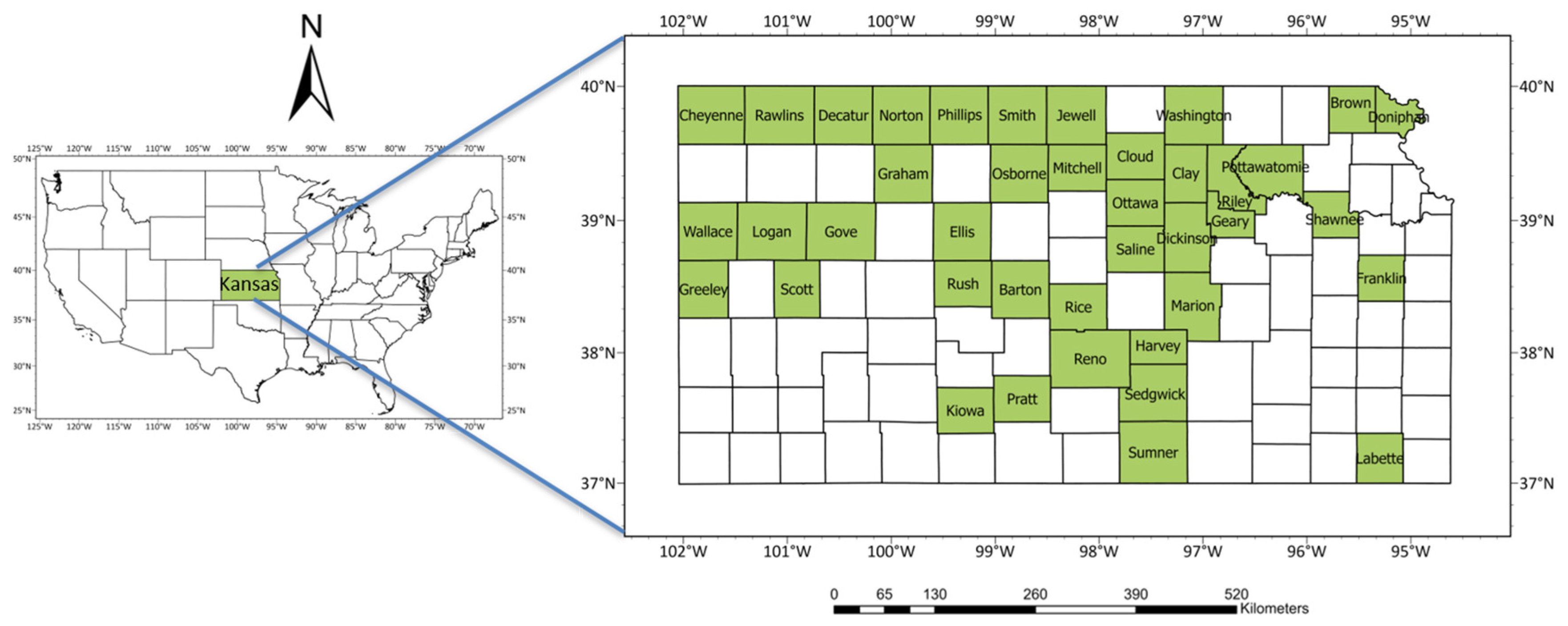
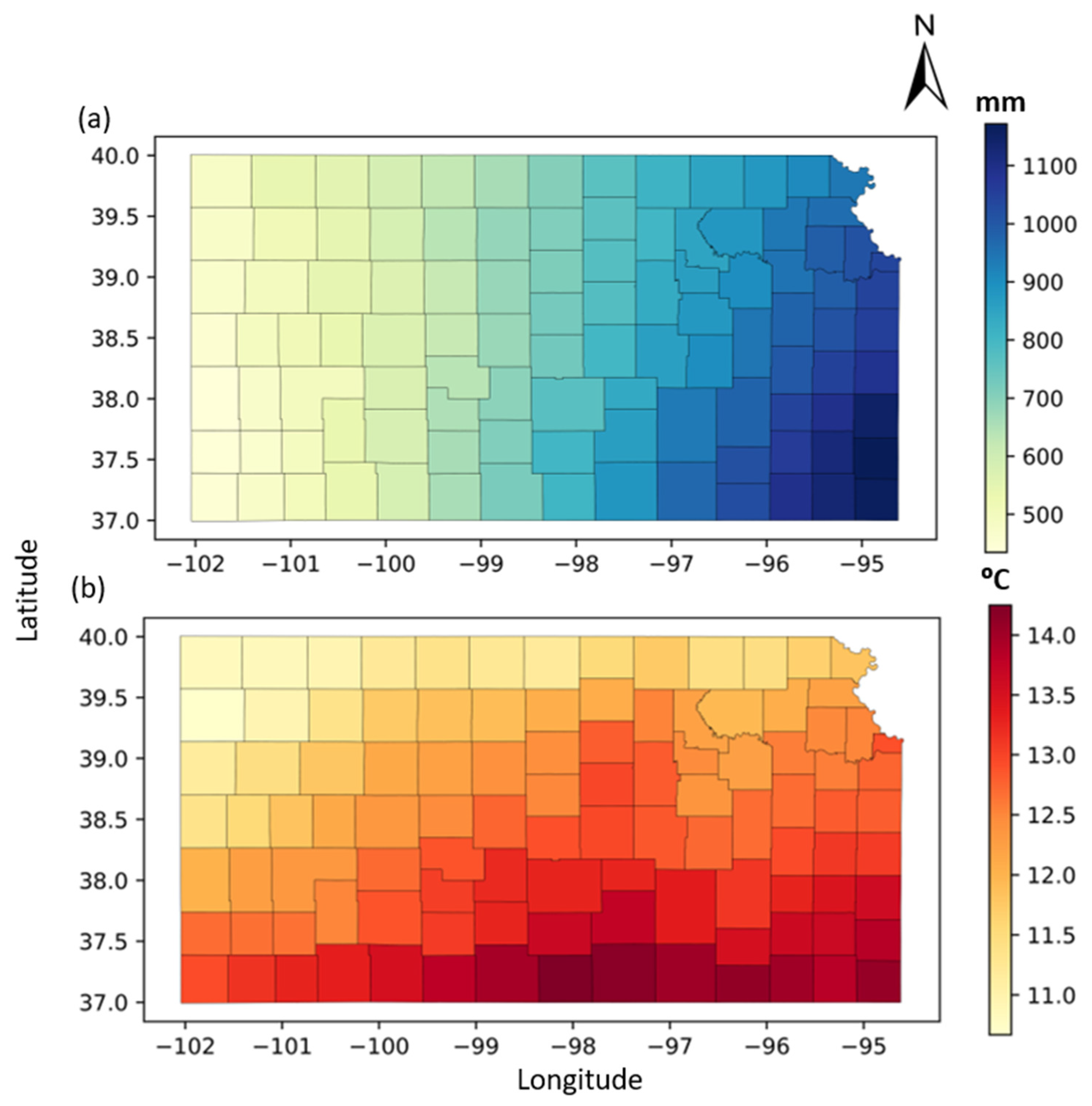
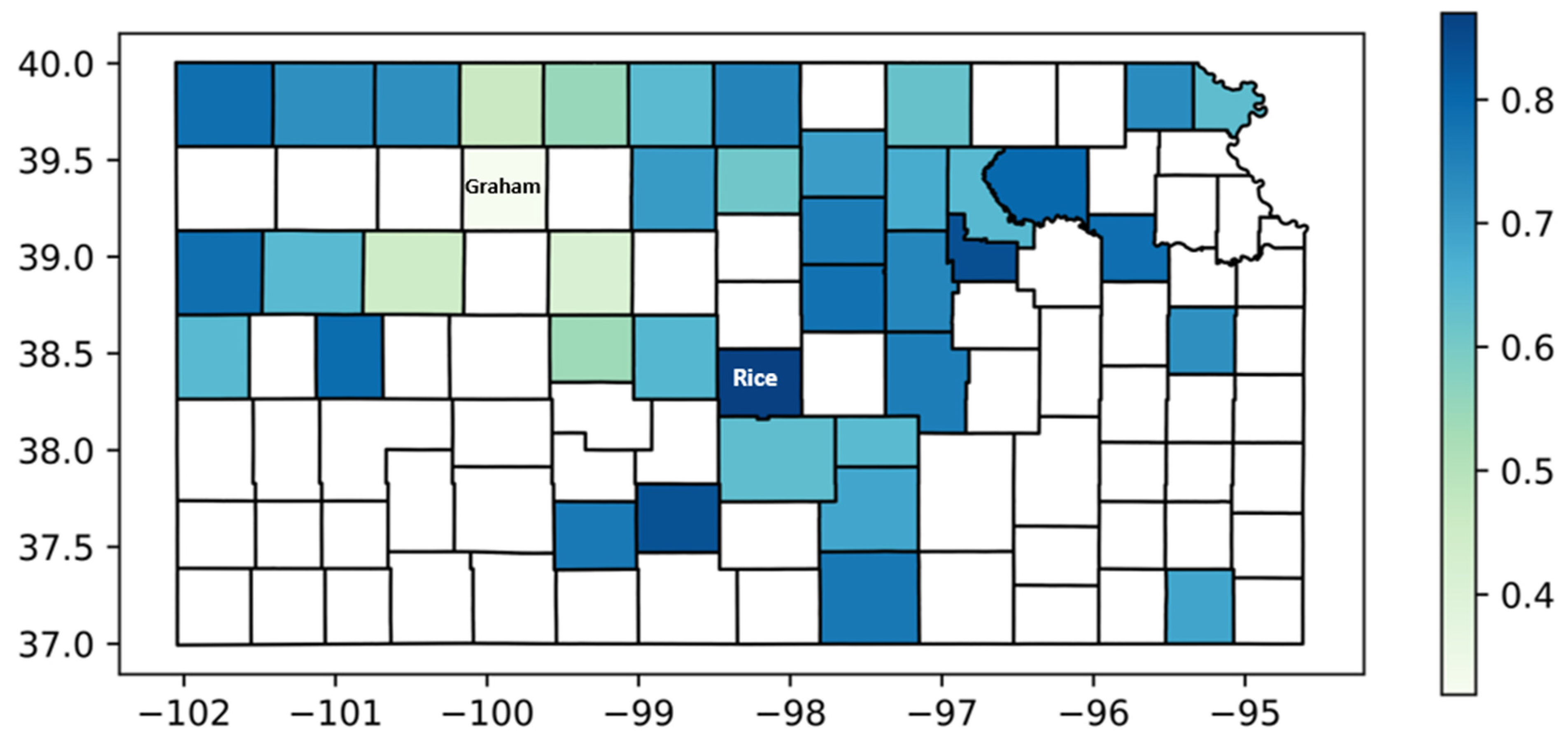
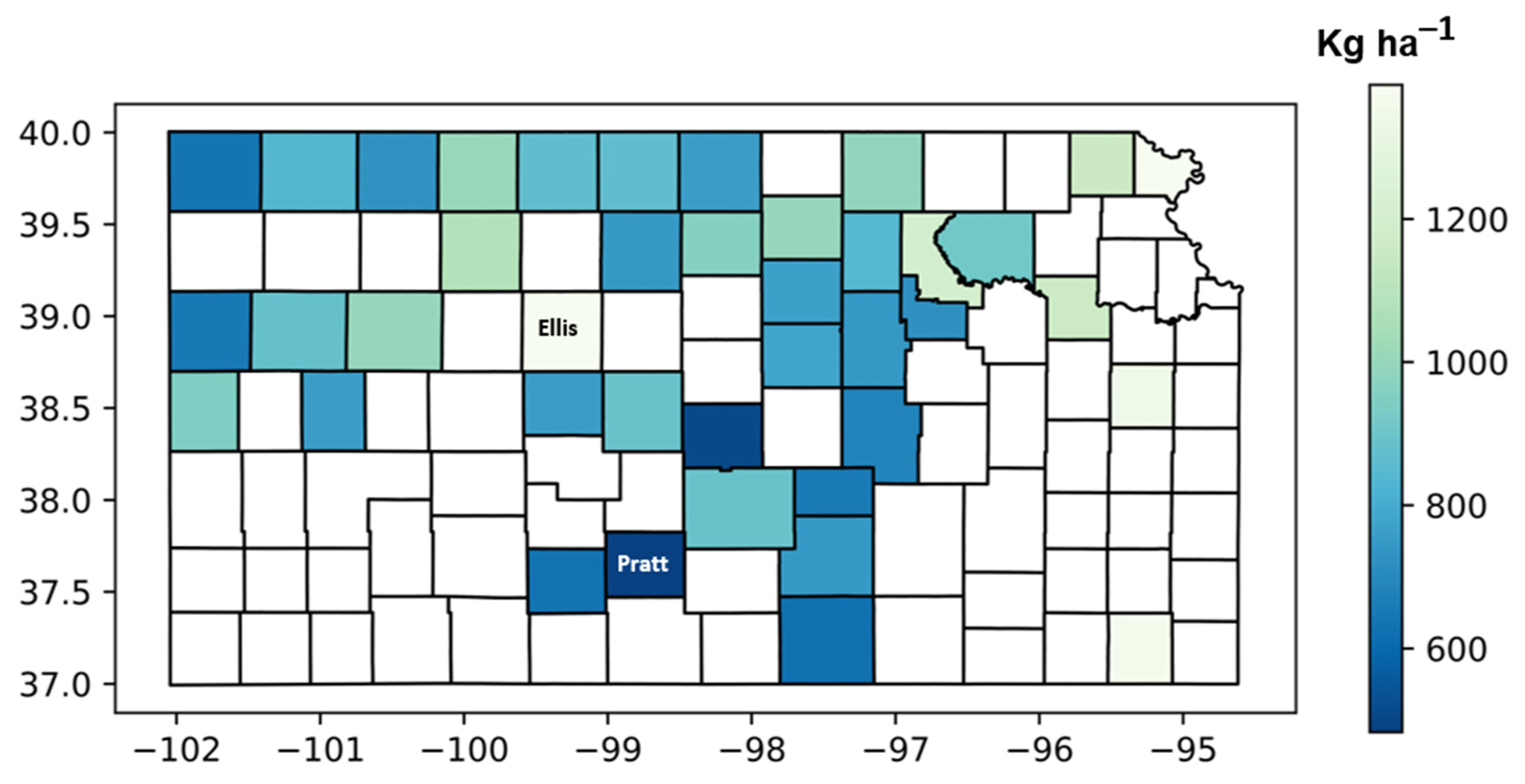
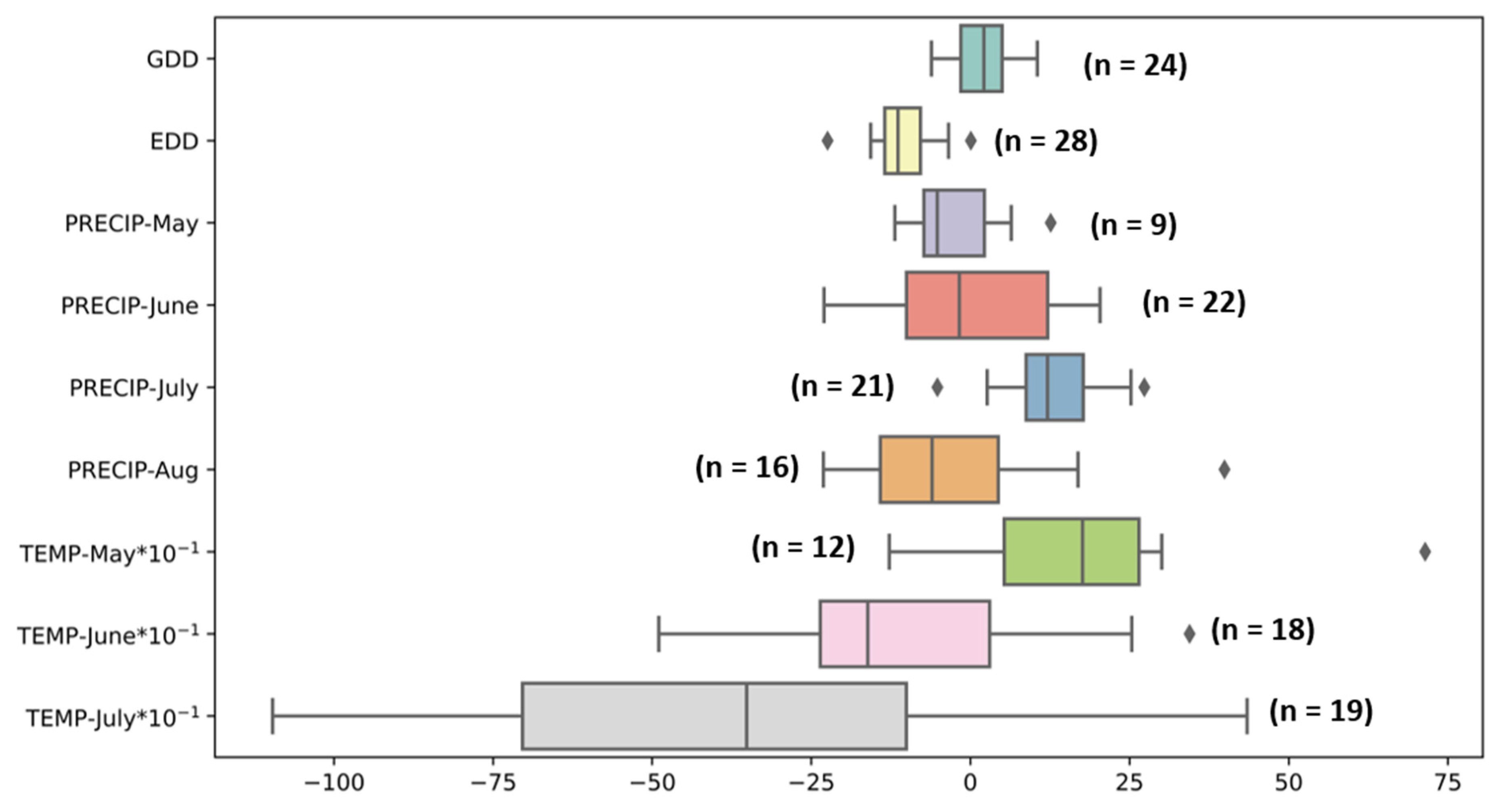


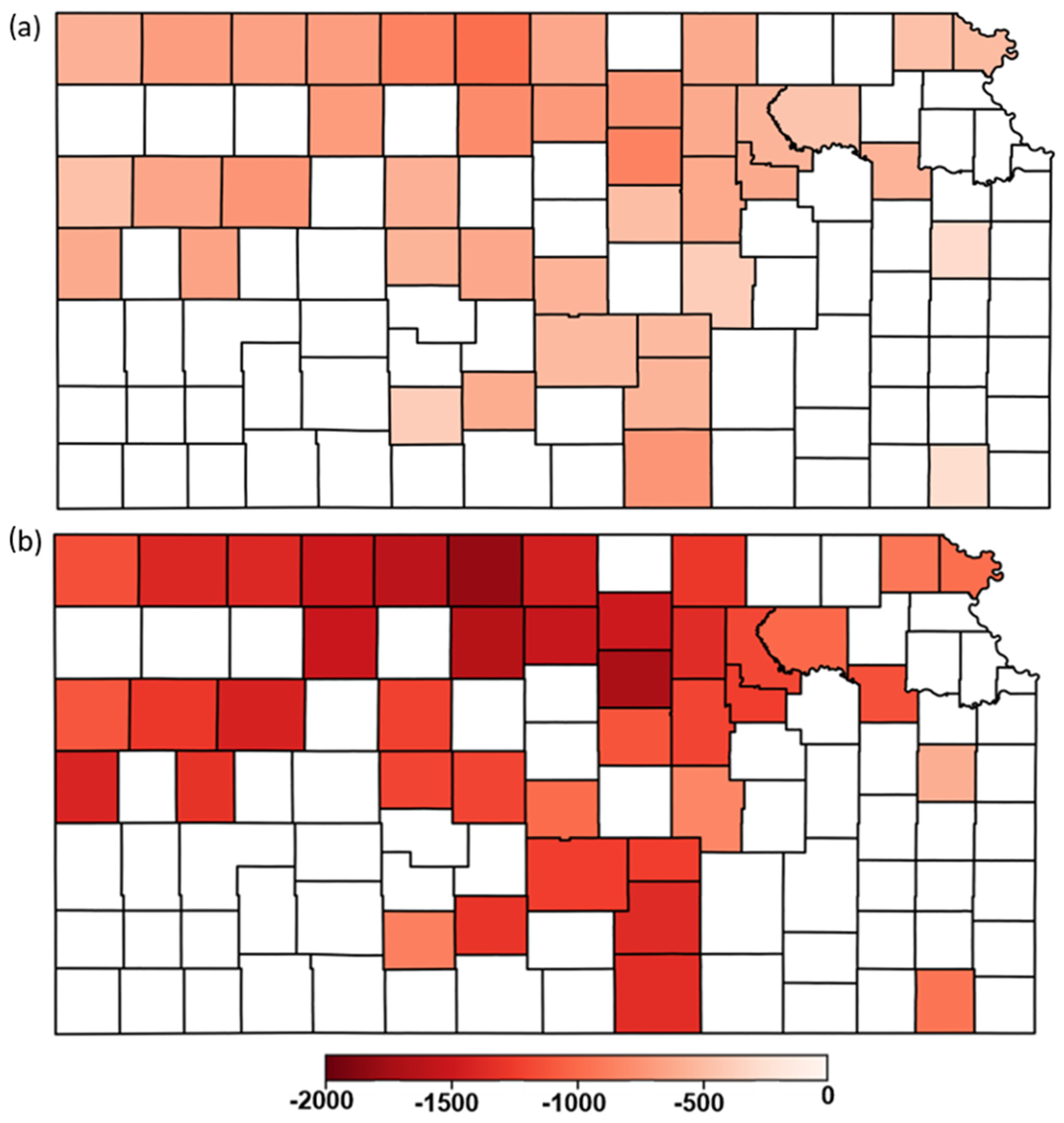
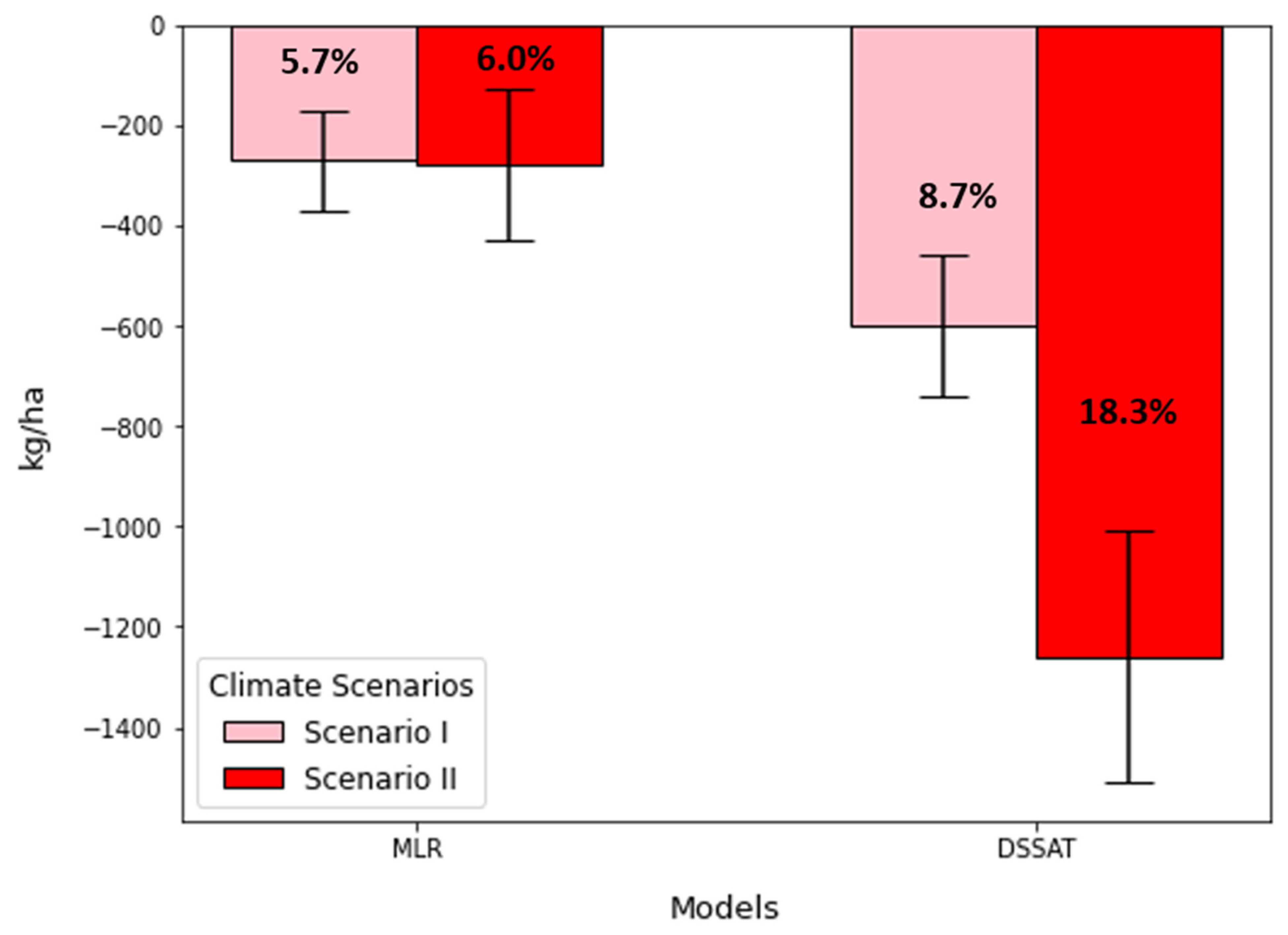
Disclaimer/Publisher’s Note: The statements, opinions and data contained in all publications are solely those of the individual author(s) and contributor(s) and not of MDPI and/or the editor(s). MDPI and/or the editor(s) disclaim responsibility for any injury to people or property resulting from any ideas, methods, instructions or products referred to in the content. |
© 2023 by the authors. Licensee MDPI, Basel, Switzerland. This article is an open access article distributed under the terms and conditions of the Creative Commons Attribution (CC BY) license (https://creativecommons.org/licenses/by/4.0/).
Share and Cite
Rawat, M.; Sharda, V.; Lin, X.; Roozeboom, K. Climate Change Impacts on Rainfed Maize Yields in Kansas: Statistical vs. Process-Based Models. Agronomy 2023, 13, 2571. https://doi.org/10.3390/agronomy13102571
Rawat M, Sharda V, Lin X, Roozeboom K. Climate Change Impacts on Rainfed Maize Yields in Kansas: Statistical vs. Process-Based Models. Agronomy. 2023; 13(10):2571. https://doi.org/10.3390/agronomy13102571
Chicago/Turabian StyleRawat, Meenakshi, Vaishali Sharda, Xiaomao Lin, and Kraig Roozeboom. 2023. "Climate Change Impacts on Rainfed Maize Yields in Kansas: Statistical vs. Process-Based Models" Agronomy 13, no. 10: 2571. https://doi.org/10.3390/agronomy13102571
APA StyleRawat, M., Sharda, V., Lin, X., & Roozeboom, K. (2023). Climate Change Impacts on Rainfed Maize Yields in Kansas: Statistical vs. Process-Based Models. Agronomy, 13(10), 2571. https://doi.org/10.3390/agronomy13102571





